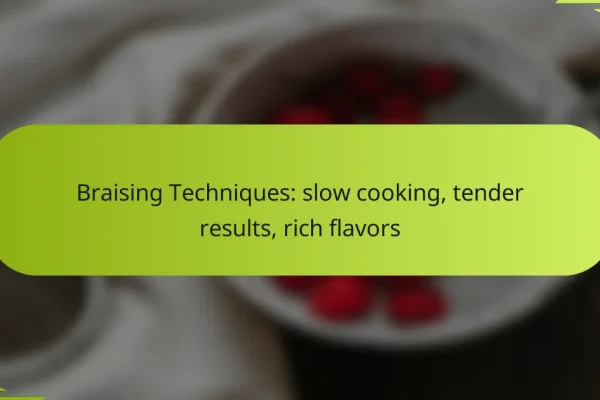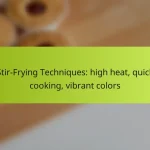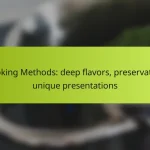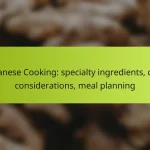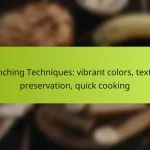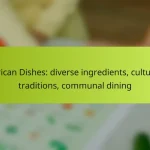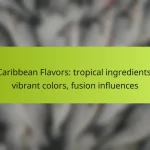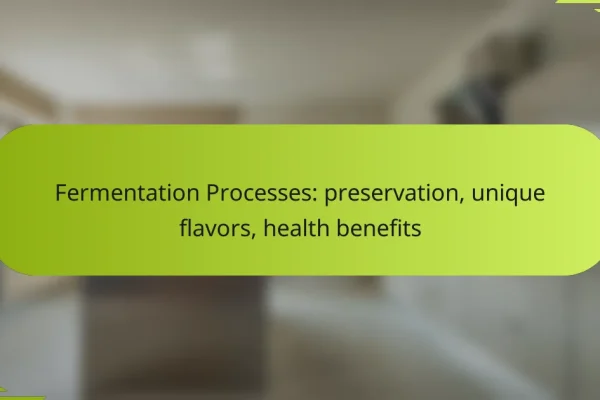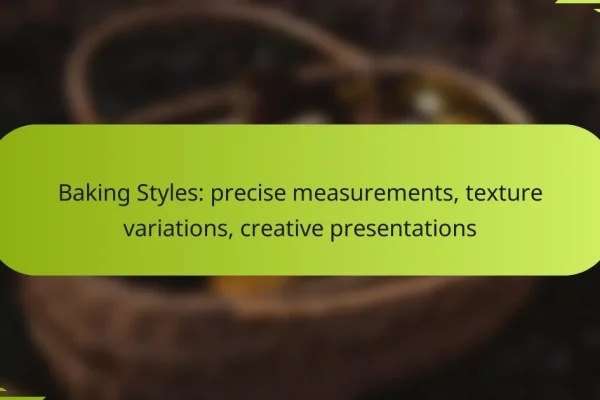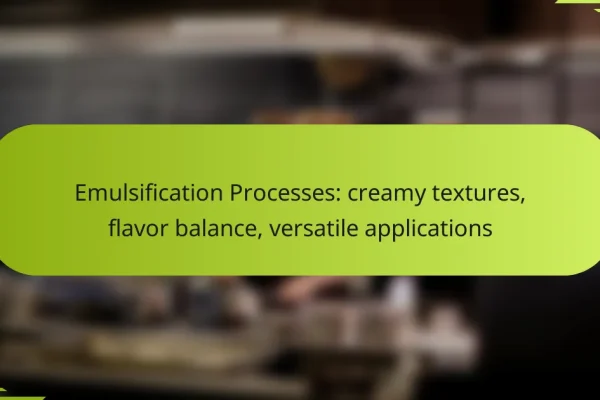What culinary techniques can enhance cooking skills?
Various culinary techniques can significantly improve cooking skills by introducing new methods and flavors. Mastering techniques such as sous vide, fermentation, smoking, stir-frying, and grilling can elevate dishes and enhance overall culinary creativity.
Sous vide cooking
Sous vide cooking involves vacuum-sealing food in a bag and immersing it in a water bath at a precise temperature. This method ensures even cooking and retains moisture, resulting in tender and flavorful dishes. It is particularly effective for meats, vegetables, and eggs.
To get started, invest in a sous vide machine and vacuum sealer. Common temperature ranges for meats are between 54°C to 60°C (130°F to 140°F) for medium-rare beef. Avoid overcooking by adhering to recommended cooking times, which can vary from one to several hours depending on the food type.
Fermentation methods
Fermentation is a natural process that uses microorganisms to convert sugars into acids or alcohol, enhancing flavor and preserving food. Techniques include making yogurt, sauerkraut, and kimchi, which not only add depth to dishes but also provide health benefits.
To ferment at home, start with simple recipes that require minimal ingredients. Ensure proper sanitation and use the right temperature, typically around 20°C to 25°C (68°F to 77°F) for most vegetable ferments. Be mindful of fermentation times, which can range from a few days to several weeks.
Smoking techniques
Smoking adds a rich, complex flavor to foods by exposing them to smoke from burning or smoldering materials, typically wood. This technique can be applied to meats, fish, and even vegetables, creating unique taste profiles.
When smoking, choose the right type of wood chips, such as hickory for pork or applewood for poultry. Use a smoker or a grill set up for indirect heat, maintaining a temperature between 90°C to 120°C (194°F to 248°F) for low and slow cooking. Monitor the internal temperature of the food to ensure it reaches safe levels.
Stir-frying
Stir-frying is a quick cooking method that involves cooking food in a small amount of oil over high heat while stirring constantly. This technique is ideal for vegetables and proteins, preserving their texture and nutrients.
To effectively stir-fry, prepare all ingredients in advance and cut them into uniform sizes for even cooking. Use a wok or a large skillet, and heat the oil until it shimmers before adding the ingredients. Aim for cooking times of just a few minutes to maintain freshness and crunch.
Grilling
Grilling is a popular cooking technique that involves cooking food over direct heat, typically on a grill. This method imparts a distinct charred flavor and is suitable for a variety of foods, including meats, vegetables, and fruits.
For successful grilling, preheat the grill and oil the grates to prevent sticking. Cooking times vary based on the food; for example, chicken breasts may take around 6 to 8 minutes per side, while vegetables can cook in just a few minutes. Use a meat thermometer to ensure meats reach safe internal temperatures.
How can I learn different culinary techniques in the UK?
To learn various culinary techniques in the UK, consider enrolling in culinary schools, taking online cooking classes, or participating in local workshops. Each option offers unique benefits and caters to different learning preferences and schedules.
Culinary schools in London
Culinary schools in London provide structured programs that cover a wide range of cooking techniques, from basic knife skills to advanced pastry making. Institutions like Le Cordon Bleu and the Westminster Kingsway College offer diploma courses that can last from several months to a couple of years.
When choosing a culinary school, consider factors such as course duration, tuition fees, and the school’s reputation. Many schools also offer part-time options, making it easier to balance studies with work.
Online cooking classes
Online cooking classes are a flexible way to learn culinary techniques from the comfort of your home. Platforms like MasterClass and Udemy offer courses taught by renowned chefs, allowing you to learn at your own pace.
Look for classes that provide interactive elements, such as live Q&A sessions or community forums, to enhance your learning experience. Prices can vary widely, so compare options to find a course that fits your budget.
Local workshops in Manchester
Local workshops in Manchester are a great way to gain hands-on experience with culinary techniques. Many community centers and cooking schools offer short courses that focus on specific skills, such as bread making or Italian cuisine.
Check local listings for upcoming workshops, as they often cater to different skill levels and can range from a few hours to full-day sessions. Participating in these workshops can also provide networking opportunities with fellow cooking enthusiasts.
What are the benefits of mastering culinary techniques?
Mastering culinary techniques offers numerous advantages, including the ability to create dishes with enhanced flavors, improved presentation, and greater efficiency in the kitchen. These benefits not only elevate the cooking experience but also impress diners and enhance overall meal enjoyment.
Improved flavor profiles
Mastering culinary techniques allows cooks to manipulate ingredients and cooking methods to achieve richer and more complex flavors. Techniques such as sautéing, braising, and roasting can intensify the natural tastes of food, bringing out subtle notes that might otherwise go unnoticed.
For example, caramelizing onions through slow cooking enhances their sweetness, while deglazing a pan after searing meat captures flavorful bits that can be transformed into a delicious sauce. Understanding how to layer flavors through various techniques can significantly elevate a dish.
Enhanced presentation skills
Presentation is a key aspect of culinary arts, and mastering techniques can dramatically improve how food is plated. Skills such as garnishing, arranging, and using contrasting colors can make a dish visually appealing, enticing diners even before they take a bite.
Consider using techniques like stacking ingredients or creating height on a plate to add interest. Simple garnishes, such as fresh herbs or a drizzle of sauce, can enhance the overall look of a dish, making it more inviting and enjoyable.
Increased cooking efficiency
Efficient cooking is essential in both home kitchens and professional settings. Mastering culinary techniques can streamline processes, reducing cooking times and minimizing waste. Techniques like mise en place, where all ingredients are prepared and organized before cooking, can help maintain focus and speed during meal preparation.
Additionally, understanding cooking times and methods for different ingredients can prevent overcooking or undercooking, leading to better results. Investing time in learning these techniques can save hours in the kitchen, allowing for more enjoyable cooking experiences.
What equipment is essential for various culinary techniques?
Essential equipment for different culinary techniques varies based on the method used, but some tools are fundamental across many cooking styles. Investing in quality equipment can enhance your cooking experience and improve results.
Sous vide precision cooker
A sous vide precision cooker allows you to cook food in a water bath at a controlled temperature, ensuring even cooking and retaining moisture. This method is ideal for meats, vegetables, and even eggs, producing tender and flavorful results.
When using a sous vide cooker, ensure that the water temperature is set correctly for the type of food being prepared. For example, cooking steak typically ranges from 54°C to 60°C (130°F to 140°F) depending on your desired doneness.
Fermentation jars
Fermentation jars are essential for creating fermented foods like pickles, kimchi, and yogurt. These jars often come with airlocks to prevent spoilage while allowing gases to escape during the fermentation process.
When selecting fermentation jars, consider the size and material. Glass jars are popular for their non-reactive properties, while larger jars can accommodate bigger batches. Ensure to follow recipes closely to achieve the right flavor and texture.
Smoker box
A smoker box is used to infuse food with smoky flavors, typically on a grill or in an oven. It holds wood chips that smolder and release smoke, enhancing meats, vegetables, and even cheeses.
Choose the right type of wood chips based on the flavor profile you desire. For instance, hickory provides a strong flavor, while applewood offers a milder, sweeter smoke. Soak the chips in water for about 30 minutes before use to prolong the smoking process.
Wok for stir-frying
A wok is a versatile cooking vessel ideal for stir-frying, steaming, and deep-frying. Its rounded shape allows for quick cooking at high temperatures, making it perfect for preparing vegetables and proteins rapidly.
When using a wok, ensure it is well-seasoned to prevent sticking and enhance flavor. Use high smoke point oils, such as peanut or canola oil, for best results. Keep all ingredients prepped and ready to go, as stir-frying is a fast-paced cooking method.
How do different culinary techniques compare?
Different culinary techniques vary in their methods, outcomes, and applications. Understanding these differences can help you choose the right technique for your dish, enhancing flavor, texture, and presentation.
Sous vide vs. traditional cooking
Sous vide involves vacuum-sealing food in a bag and cooking it in a water bath at a precise temperature, ensuring even cooking and retaining moisture. In contrast, traditional cooking methods like boiling or frying often rely on higher temperatures and direct heat, which can lead to uneven cooking and moisture loss.
When using sous vide, the cooking time can range from one hour to several hours, depending on the food type and thickness. Traditional methods may require shorter cooking times but often involve more attention to prevent overcooking.
For best results with sous vide, invest in a reliable immersion circulator and use a food-safe vacuum sealer. Avoid cooking delicate items like fish for too long, as they can become mushy.
Grilling vs. roasting
Grilling involves cooking food over direct heat, typically on a grill or barbecue, which imparts a smoky flavor and creates a charred exterior. Roasting, on the other hand, uses indirect heat in an oven, allowing for even cooking and caramelization of the food’s surface.
Grilling is usually faster, taking anywhere from a few minutes to an hour, depending on the food. Roasting can take longer, often requiring 30 minutes to several hours, especially for larger cuts of meat or whole vegetables.
When grilling, keep an eye on the temperature to prevent flare-ups and burning. For roasting, use a meat thermometer to ensure the internal temperature reaches safe levels, typically around 75°C for poultry and 63°C for beef.
Fermentation vs. pickling
Fermentation is a natural process where microorganisms like bacteria and yeast convert sugars into acids, gases, or alcohol, enhancing flavor and preserving food. Pickling, however, involves soaking food in a brine or vinegar solution, which can also preserve and flavor the food but does not rely on microbial activity.
Fermentation can take days to weeks, depending on the food and desired flavor, while pickling is generally quicker, often requiring just a few hours to a couple of days for the flavors to develop.
For successful fermentation, ensure a clean environment and proper temperature, typically around 20-25°C. When pickling, use high-quality vinegar and ensure the food is fully submerged in the brine to prevent spoilage.
What are the trends in culinary techniques for 2024?
In 2024, culinary techniques are increasingly focused on sustainability, technology integration, and global fusion. Chefs are adopting methods that emphasize plant-based ingredients, innovative cooking technologies, and the blending of diverse culinary traditions.
Plant-Based Cooking Techniques
Plant-based cooking is gaining momentum as chefs explore creative ways to highlight vegetables, grains, and legumes. Techniques such as fermentation, smoking, and sous-vide are being used to enhance flavors and textures in plant-based dishes. This trend not only caters to health-conscious consumers but also aligns with environmental sustainability.
To effectively implement plant-based techniques, consider using seasonal ingredients to maximize flavor and nutritional value. Experimenting with spices and herbs can elevate simple dishes, making them more appealing. Avoid common pitfalls like overcooking vegetables, which can diminish their taste and nutrients.
Integration of Technology in Cooking
Technology is transforming culinary practices, with tools like sous-vide machines, precision cookers, and smart kitchen appliances becoming commonplace. These innovations allow for greater control over cooking times and temperatures, resulting in consistent and high-quality dishes. Chefs are also utilizing apps and online platforms for recipe sharing and collaboration.
When incorporating technology, start with one or two tools that complement your cooking style. Familiarize yourself with their functionalities to maximize their potential. Remember to balance traditional techniques with modern technology to maintain the essence of culinary art.
Global Fusion Techniques
Global fusion techniques are on the rise as chefs blend flavors and cooking styles from various cultures. This approach encourages creativity and experimentation, leading to unique dishes that reflect diverse culinary heritages. Techniques such as cross-marination and hybrid cooking methods are popular in this trend.
To successfully create fusion dishes, research the flavor profiles and cooking methods of different cuisines. Start with familiar ingredients and gradually introduce new elements to avoid overwhelming the palate. Be mindful of balancing flavors to ensure that no single element dominates the dish.
